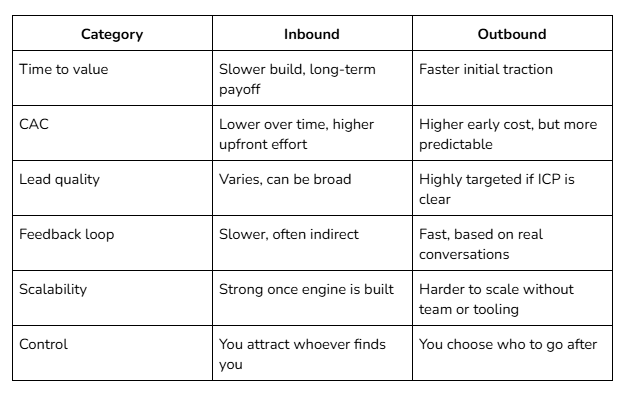%20(1).png)
Outbound vs. Inbound in GTM: Which Should You Prioritize?
%20(1).png)
If you’re launching a new SaaS product, building a pipeline is usually priority number one. But then comes the inevitable question:
Should we go outbound first? Or invest in inbound?
Both sound right. Both get thrown around in every growth meeting. But choosing the wrong one too early can waste time, burn budget, and leave you chasing leads that were never a fit.
Here’s what we’ve seen work across early-stage B2B SaaS teams, and how to choose the right motion based on your GTM goals, team size, and product maturity.
SaaS inbound marketing is all about attraction. You create value in public, build trust over time, and generate demand from people who are already searching, browsing, or problem-aware. It typically includes:
The upside: it compounds over time. The downside: it takes time to compound.
Outbound is proactive. You define your ICP, build a list, and initiate contact. This includes:
The upside: quick feedback loops and control over who you target. The downside: high effort and potentially high CAC if done without a strategy.
Here’s how they stack up when you’re building a go-to-market strategy.

Depends on your stage. Here’s how we’d recommend it.
Start with outbound.
At this stage, you’re still figuring out who your best customers are. Outbound helps you get direct signal. You can run short sprints to test messaging, pain points, objections, and willingness to pay. It’s scrappy, it’s manual, but it gives you real conversations fast.
You don’t need to build a big content engine yet. Just a strong landing page, a clear pitch, and a founder who can talk to users.
Add light inbound later. Post on LinkedIn. Share product updates. Publish your positioning doc as a Notion page. But don’t let inbound become a distraction if you’re still pre-PMF.
This is when you start investing properly in SaaS inbound marketing.
You’ve seen what messaging lands. You’ve sold beyond your warm network. You want repeatable, sustainable lead flow.
Start by building:
You still keep outbound in play, especially for high ACV deals or strategic accounts. But now, outbound and inbound start to inform each other. Outbound reveals objections. Inbound answers them.
| Also Read: Go-To-Market vs Marketing Strategy: The Mistake That Stalls Early-Stage SaaS |
At this point, inbound should be its own system. You’re not writing content for the sake of writing. You’re tracking search intent, building authority, and distributing content across channels that actually convert.
Your marketing team should be owning distribution, repurposing content, and analyzing channel ROI. Your sales team should be getting warmer leads from content, events, and search.
Outbound still works, but becomes more specialized. Strategic accounts. Events. Expansion plays. You’re no longer reliant on it to generate all net-new pipeline.
This is where most of the confusion happens. People assume inbound is cheaper and outbound is expensive. The truth is more nuanced.
Here’s what we usually see:

Outbound gives you quick feedback, but caps out without strong targeting or personalization. Inbound takes longer, but compounds if you’ve nailed your positioning.
Don’t compare cost per lead without comparing time-to-feedback and strategic value. Early ROI is not the same as long-term ROI.
Eventually, yes. But not at the same time, and not at equal intensity.
Trying to build outbound and inbound from scratch with a small team is how GTM strategies collapse. Your designer is writing blog posts. Your founder is juggling cold email copy with demo calls. Your SEO agency is asking for buyer personas you haven’t figured out yet.
Instead, do this:
This isn’t about “either-or.” It’s about sequence and stage.
Most teams don’t fail because they chose the wrong motion. They fail because they chose both, too early, with no focus.
If you don’t know your ICP, start with outbound.
If you have traction and want to scale efficiently, build inbound.
If you’re not sure, talk to people who’ve done this before.
At Groie, we help early-stage B2B SaaS teams go from zero to scalable GTM. That includes helping you choose the right growth motion, test positioning, and build the systems that don’t fall apart when your team scales from 3 to 30.
If your funnel feels chaotic or your leads don’t convert, let’s chat. No fluff. No decks. Just a sharp plan.